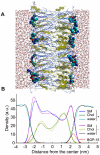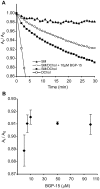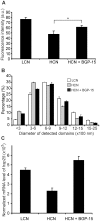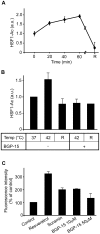Membrane-lipid therapy in operation: the HSP co-inducer BGP-15 activates stress signal transduction pathways by remodeling plasma membrane rafts
- PMID: 22174906
- PMCID: PMC3236211
- DOI: 10.1371/journal.pone.0028818
Membrane-lipid therapy in operation: the HSP co-inducer BGP-15 activates stress signal transduction pathways by remodeling plasma membrane rafts
Abstract
Aging and pathophysiological conditions are linked to membrane changes which modulate membrane-controlled molecular switches, causing dysregulated heat shock protein (HSP) expression. HSP co-inducer hydroxylamines such as BGP-15 provide advanced therapeutic candidates for many diseases since they preferentially affect stressed cells and are unlikely have major side effects. In the present study in vitro molecular dynamic simulation, experiments with lipid monolayers and in vivo ultrasensitive fluorescence microscopy showed that BGP-15 alters the organization of cholesterol-rich membrane domains. Imaging of nanoscopic long-lived platforms using the raft marker glycosylphosphatidylinositol-anchored monomeric green fluorescent protein diffusing in the live Chinese hamster ovary (CHO) cell plasma membrane demonstrated that BGP-15 prevents the transient structural disintegration of rafts induced by fever-type heat stress. Moreover, BGP-15 was able to remodel cholesterol-enriched lipid platforms reminiscent of those observed earlier following non-lethal heat priming or membrane stress, and were shown to be obligate for the generation and transmission of stress signals. BGP-15 activation of HSP expression in B16-F10 mouse melanoma cells involves the Rac1 signaling cascade in accordance with the previous observation that cholesterol affects the targeting of Rac1 to membranes. Finally, in a human embryonic kidney cell line we demonstrate that BGP-15 is able to inhibit the rapid heat shock factor 1 (HSF1) acetylation monitored during the early phase of heat stress, thereby promoting a prolonged duration of HSF1 binding to heat shock elements. Taken together, our results indicate that BGP-15 has the potential to become a new class of pharmaceuticals for use in 'membrane-lipid therapy' to combat many various protein-misfolding diseases associated with aging.
Conflict of interest statement
Figures






Similar articles
-
Rac1 participates in thermally induced alterations of the cytoskeleton, cell morphology and lipid rafts, and regulates the expression of heat shock proteins in B16F10 melanoma cells.PLoS One. 2014 Feb 20;9(2):e89136. doi: 10.1371/journal.pone.0089136. eCollection 2014. PLoS One. 2014. PMID: 24586549 Free PMC article.
-
Imaging of mobile long-lived nanoplatforms in the live cell plasma membrane.J Biol Chem. 2010 Dec 31;285(53):41765-71. doi: 10.1074/jbc.M110.182121. Epub 2010 Oct 21. J Biol Chem. 2010. PMID: 20966075 Free PMC article.
-
Chaperone co-inducer BGP-15 inhibits histone deacetylases and enhances the heat shock response through increased chromatin accessibility.Cell Stress Chaperones. 2017 Sep;22(5):717-728. doi: 10.1007/s12192-017-0798-5. Epub 2017 May 4. Cell Stress Chaperones. 2017. PMID: 28474205 Free PMC article.
-
Hydroximic acid derivatives: pleiotropic HSP co-inducers restoring homeostasis and robustness.Curr Pharm Des. 2013;19(3):309-46. doi: 10.2174/138161213804143716. Curr Pharm Des. 2013. PMID: 22920902 Review.
-
Plasma membranes as heat stress sensors: from lipid-controlled molecular switches to therapeutic applications.Biochim Biophys Acta. 2014 Jun;1838(6):1594-618. doi: 10.1016/j.bbamem.2013.12.015. Epub 2013 Dec 27. Biochim Biophys Acta. 2014. PMID: 24374314 Review.
Cited by
-
Electroretinographical Analysis of the Effect of BGP-15 in Eyedrops for Compensating Global Ischemia-Reperfusion in the Eyes of Sprague Dawley Rats.Biomedicines. 2024 Mar 13;12(3):637. doi: 10.3390/biomedicines12030637. Biomedicines. 2024. PMID: 38540250 Free PMC article.
-
The Clinical Validation of Modulated Electro-Hyperthermia (mEHT).Cancers (Basel). 2023 Sep 15;15(18):4569. doi: 10.3390/cancers15184569. Cancers (Basel). 2023. PMID: 37760538 Free PMC article. Review.
-
Crosstalk between Lipid Rafts and Aging: New Frontiers for Delaying Aging.Aging Dis. 2022 Jul 11;13(4):1042-1055. doi: 10.14336/AD.2022.0116. eCollection 2022 Jul 11. Aging Dis. 2022. PMID: 35855333 Free PMC article.
-
Quantitative Comparison of HSF1 Activators.Mol Biotechnol. 2022 Aug;64(8):873-887. doi: 10.1007/s12033-022-00467-3. Epub 2022 Feb 26. Mol Biotechnol. 2022. PMID: 35218516 Free PMC article.
-
Lipids in Pathophysiology and Development of the Membrane Lipid Therapy: New Bioactive Lipids.Membranes (Basel). 2021 Nov 24;11(12):919. doi: 10.3390/membranes11120919. Membranes (Basel). 2021. PMID: 34940418 Free PMC article. Review.
References
-
- Vígh L, Horváth I, Maresca B, Harwood J. Can the stress protein response be controlled by ‘membrane-lipid therapy’? Trends Biochem Sci. 2007;32:357–363. - PubMed
-
- Vígh L, Literáti NP, Horváth I, Török Z, Balogh G, et al. Bimoclomol®: A nontoxic, hydroxylamine derivative with stress protein-inducing activity and cytoprotective effects. Nat Med. 1997;3:1150–1154. - PubMed
-
- Sloan L, Fillmore M, Churcher I. Small-molecule modulation of cellular chaperones to treat protein misfolding disorders. Current Opin Drug Disc. 2009;12:666–681. - PubMed
Publication types
MeSH terms
Substances
Grants and funding
LinkOut - more resources
Full Text Sources
Research Materials
Miscellaneous

